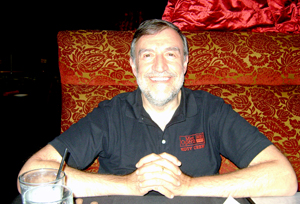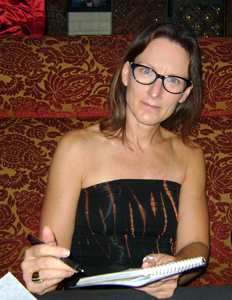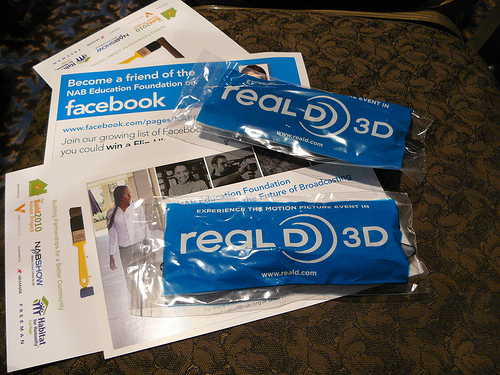2010 NAB Show Standouts
LAS VEGAS: One fixture at the NAB Show has methodically plied the exhibit floor for more than 30 years. Mark Schubin, engineer in charge at the Metropolitan Opera and possibly one of the most renowned video experts in the business, walks down each aisle at least twice, speed-reading every display.
“3D is kind of dimming everything,” he says, walking at his usual deliberate pace through the South Hall on Tuesday. He stops short when something catches his eye. The TV Logic OLED 3D monitor. Schubin dons the specs, takes a look, moves on.
Monitors displaying 3D images are so prevalent they nearly cause second-hand eye fatigue. Schubin is not a 3D proselytizer by any stretch. He’s seen the format come and go many times, and often lectures on the deleterious physical effects of 3D gone wrong. However, 3D is catching the public’s imagination as never before, and media companies--and their suppliers--are responding. With a potential live 3D opera cinecast in mind, Schubin found some noteworthy technologies on the NAB Show floor.
I joined my long-time friend, mentor and teacher for dinner the night before he left Las Vegas. He shared his notables, logged on a single sheet of paper in neat, miniscule hand.
He was veritably excited about a Pace-Fujinon camera configuration that allowed for simultaneous shooting of 2D and 3D. Right now, two distinct operations are required to shoot 2D and 3D, and 3D-only coverage is not likely anytime soon. The majority of viewing is still in 2D. Pace and Fujinon have coupled 3D and 2D cameras for a single operator who can zoom the different lenses at a synched or differentiated rate.
A fan of Fraunhofer, Schubin said the Munich, Germany concern was showing 3D stereoscopic software that enabled not just two, but up to nine views, possibly more. The more views, the lower the resolution, but he said five looked “not bad.”
High-speed camera specialist Vision Research of Wayne, N.J., was showing high-speed 3D, eliciting an affirmation of “cool.”
A company by the name of Ateme had a 3D explanation chart covering set-up and transmission for the various stereoscopic formats. Another, Monogram, has a “3DTV station in a box” that appears to work as advertised, he said.
Belden even brought 3D wire in the form of 1694D dual, red-green color-coded cable.
In the polar-opposite-of-3D arena, Schubin said there were signs on the floor that “tape is not dead.” He said Sony rolled out new videotape gear, and a relatively new archiving tape, LTO-5, was on display. To boot, For-A and Cache-A have come up with a way to record directly to LTO-5, effectively creating… wait for it… yet another tape format.
Other non-3D items on the Schubin cheat sheet included Panasonic’s AG-AF400 camera under glass. He said it was basically a Lumix GH1 still camera rendered into a high-sensitivity video camera with a shallow depth of field. (From Flickr member Kemper, who took the accompanying image of the AG-AF400: “I want one!”)
NTT showed “Fun TV,” a 4K signal with selectable views. NICT showed something similar last year, Schubin said.
This year’s NAB Show was the first to feature what Schubin referred to as “ghetto” organization, in that similar exhibitors were placed together in somewhat segregated areas. He discovered an “Academic Ghetto” in South Hall where several schools were displaying research projects.
Ryerson University in Toronto was doing research on how people actually watch different video formats.
“They’ve shot things in 4K, 4K3D and hi-def, and they have an eye-tracking system to see what viewers eyes are doing while they are watching.”
The research can inform videographers, cinematographers, producers and directors, he said. Different focuses may be optimal for different formats. No resulting data is yet available.
Another research lab--Aerial 3D--was demonstrating volumetric laser display. “You’re actually looking around the image,” Schubin said, though it’s not technically holography. He likened the display to a lava lamp.
Over in the “ghetto for cellular modems,” Schubin found Streamcast claiming to bond up to four high-speed cellular modems to create one 20 Mbps channel “where ever you can get a cell signal.” E.g., anywhere in Vegas but Central Hall. Two other companies—TVU and Verizon--were showing video-over-ceullar network technology.
Schubin was delighted to find joystick-editing inventor Dennis Christensen at the show. Christensen was in the Leader booth with microwave technology that carried uncompressed video in the 60 GHz band with zero latency. Schubin said Fuji TV showed similar technology at IBC two years ago, but “these guys reduced it to a chip.” It can go in a cell phone to download movies from a kiosk, or be used as a professional microwave link. The smaller size would allow far greater flexibility in locating temporary microwave links for live events like bike races and marathons. And because it’s in the 60 GHz, it wouldn’t have to be licensed.
Fraunhofer had an ultra low-latency transmission codec that Schubin described as “awfully close to zero.”
HaiVision made his “fun” category for bringing a tank full of sharks, reflecting the company emblem. Only these were real sharks. Nine of them. None were wearing 3D glasses.
A lot of human beings put on 3D glasses at the show, but not all of them saw 3D images being displayed, Schubin said.
“I went to a booth with active glasses and put them on… someone else came over and put on the active glasses and watched. He said, ‘did it work?’ I said, ‘yeah.” He said, ‘I didn’t see it.’ I said, ‘you have to turn the glasses on.’ I saw this throughout the show.”
And finally, for the man who takes thematic T-shirts to a whole new level of sartoriality--his favorite of the show: “Are you real, or is this 3DTV?”
The 2010 NAB Show runs through tomorrow. Mark Schubin’s musings are available at www.SchubinCafe.com. Enjoy, and travel safe.
-- Deborah D. McAdams
(AF-400 and RealD images by Kemper)




The professional video industry's #1 source for news, trends and product and tech information. Sign up below.
